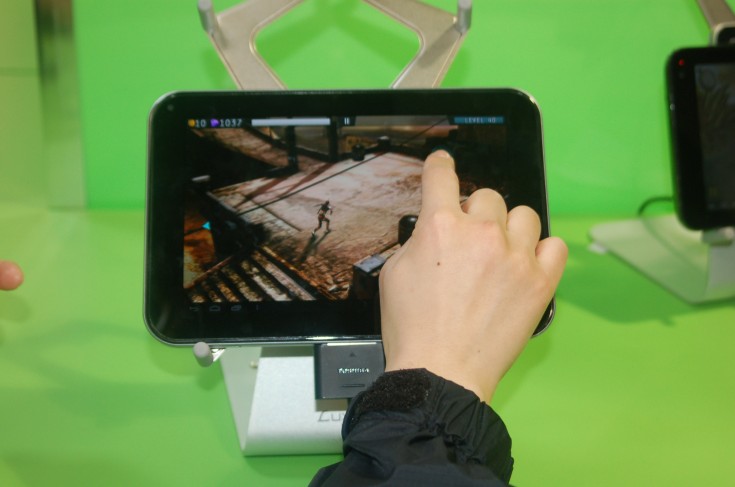In an interview with iTers News.com, Matt Wuebbling, director of product marketing with Nvidia, said that Nvidia’s recent acquisition of basband processor maker Icera has helped it to win big in the AP market.
iTers News) Please tell me how many design–wins for Tegra APs have you got so far?
Matt Wuebbling) The big news for Nvidia here at MWC2012 is a proliferation of Tegra 3-powered superphones. A lot of them came out yesterday and early last week, including HTC 1X smartphone. This is the first partnership with HTC ever, a big deal for the company. The No. 2 news is we got a design-win for LG Electronics 4X HD Optimus 2 with 720 p display of Tegra 3 CPU.
We also announced we had won a deal with ZTE of China for two ZTE phones --- one with Tegra 3 CPU and and Icera 415 baseband modem chip and another with Tegra 2 and Icera 450 baseband chip .
Icera has been obviously doing a lot of business with ZTE as data partner for so long time. We are really excited that Icera is going into the phone for the first time. That’s a big deal for the company. The fifth phone, which incorporated Tegra 3, is Tianyu’s K-touch Treasure K8 smartphone.

iTers News) How about your design activities for tablet PCs?
Matt Wuebbling) That’s all of the big news about Tegra 3. Another piece of Tegra 3 we are now aging to talk about is not just quad-core, but quad-core 4 plus one. We have been talking about having this 5th CPU core for battery saving.
The core 4 plus one is what Tegra 3 is different from other CPUs. That’s a phone side. We are also announcing new Tegra 3 tablets. Toshiba announced 7.7-inch and 13.3-inch Tegra 3 tablet PCs. Asus unveiled low-cost Transformer Pad 300 tablet PC with Tegra 3 CPU. And, ZTE released 7 -inch and 10-inch tablet PC that incorporated Tegra 3 CPU.
We have another big news. We announced Sonic from Sega will become the industry’s first console game version for Tegra 3. It has brought about lots of brand recognition, because people know well about Sega.
We have ecosystem news. There are lots of questions about LTE and Tegra 3. We have announced partnership with Renesas Electronic Corporation as well as GCT, both of which working on their respective base band modem chip.
STE is also working on LTE modem and bring out them for the integration with Tegra 3. Obviously, lots of partners are asking for a pairing of LTE with Tegra 3.
iTters News) What else do you have on your technology portfolio?
Matt Wuebbling) Direct touch is a technology we introduced in CES. Technology about uploading some other touch screen processing on Tegra 3. Just again partnership with touch controller the guys who makes analog to digital converter, Atmel Cypress and Synaptics, big touch controller guys.
The last one is Icera is demonstrating LTE gaming here in the booth. LTE chipset i410 Icera, which is primarily data LTE modem. We are showing gaming and up for partners are showing voice over LTE demo from Alcera using the same chipset. Their LTE modem is just data. They are working on a lot of R&D and we are expecting some more technology from Icera.

iTers News) Could you give me more details on Tegra 3 technological DNA
Matt Wuebbling) Tegra 3 is going into mainstream markets. Our acquisition of Icera enables us to reach some price points with an integration, I mean, obviously discrete system level integration with AP Tegra processor and Icera.
Leading to some technology what we will have next year, we will produce Grey which is the first integration chipset. 9 months after the acquisition, Icera technology is rapidly going into phones. We are going to be able to integrate Icera technology into single SOC to promote it in mainstream markets.
iTers News) Could you tell a lot more about Tegra 3's power budget scheme, especially one plus core?
Matt Wuebbling) That core, we call it a companion core. Now, we stated to call a battery save core. The way we work with it is just very high level, The way we work is we have a fifth core, which is automatically from in video software, recognizing work flow of system and then automatically turning out a performance cores, a high performance cores, or a battery save core.
Any OS is automatically putting software switching between two cores. As a touch controller piece, the logic that drive the touch can be running on either low power core, or performance core.
For instance on your phone, just touch, what is doing is just waiting for touch pen . The algorithm is running on this, if your fourth performance core is off, a companion shadow battery save core is on. The touch algorithm is running on the battery sav core. Just be waiting for on very low power. Once you touch, you start playing game, your battery save core turned off . All of OS processing as well as touch processing transfer onto the performance core. The fifth is running on whatever you need to run touch processing when you ensure low power mode, all of that is transferring on performance core when you doing something actively.
Each of them are sort of typical SMP, symmetric multiprocessing unit. You need to be cache cogency between each one of the units to ensure the same access to cache. The Arm architecture allows for that. ARM is multiprocessor architecture, just putting together lots of pieces.

